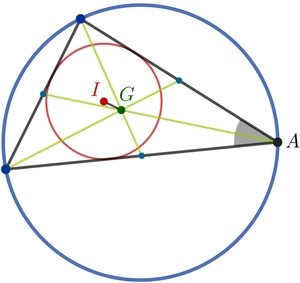Minimising G I

A triangle with a given angle A is inscribed in a unit circle. If G I min denotes the minimum possible distance between the centroid G and the incenter I of the triangle, then
G I min = ⎩ ⎪ ⎪ ⎪ ⎪ ⎪ ⎨ ⎪ ⎪ ⎪ ⎪ ⎪ ⎧ k n sin 2 ( 2 A ) l + n sin 2 ( 2 A ) l − m sin 2 ( 2 A ) 3 2 ( 1 − sin ( 2 A ) ) ∣ ∣ ∣ ∣ 2 sin ( 2 A ) − 1 ∣ ∣ ∣ ∣ if 0 ≤ A ≤ α if α ≤ A ≤ π
for some critical angle α and positive coprime integers k , l , m , and n . Submit k + l + m + n .
The answer is 13.
This section requires Javascript.
You are seeing this because something didn't load right. We suggest you, (a) try
refreshing the page, (b) enabling javascript if it is disabled on your browser and,
finally, (c)
loading the
non-javascript version of this page
. We're sorry about the hassle.
1 solution
@Mark Hennings it took me a while to fully understand your solution of the problem for minimizing HI but I did and I managed to solve this problem by myself! And also I didn't find that formula for GI and hat to derive it from this: G I = 9 ( a + b + c ) − a 3 − b 3 − c 3 + 2 a 2 b + 2 b 2 c + 2 c 2 a + 2 a b 2 + 2 b c 2 + 2 c a 2 − 9 a b c PS: Was the problem with HI with more cases than this one because the inequality u < u ^ had more turning points?
Log in to reply
Well done. Yes, the H I problem was more involved because it was possible for the quantity to be minimized at either end as well as in the interior of the region [ u , 1 ] for x , while G I never reaches it minimum at u .
The distance G I is given by the formula 9 G I 2 = 5 r 2 − 1 6 R r + s 2 where r , R , s are the inradius, outradius and semiperimeter respectively. If we set u = s i n 2 1 A and x = cos 2 1 ( B − C ) , then we have 0 < u < x < 1 and r s = 4 R sin 2 1 A sin 2 1 B sin 2 1 C = 2 R u [ cos 2 1 ( B − C ) − cos 2 1 ( B + C ) ] = 2 R u ( x − u ) = R ( sin A + sin B + sin C ) = R ( sin A + 2 sin 2 1 ( B + C ) cos 2 1 ( B − C ) ) = R ( sin A + 2 cos 2 1 A x ) = 2 R 1 − u 2 ( x + u ) and hence, since R = 1 in this case, 9 G I 2 = F u ( x ) = 2 0 u 2 ( x − u ) 2 − 3 2 u ( x − u ) + 4 ( 1 − u 2 ) ( x + u ) 2 We wish to minimize F u ( x ) over the range u < x < 1 . Since F u ′ ( x ) = 8 [ ( 1 + 4 u 2 ) x − 3 u ( 1 + 2 u 2 ) ] we see that F u is minimized globally at x = u ^ , where u ^ = 1 + 4 u 2 3 u ( 1 + 2 u 2 ) It is easy to see that u ^ > u for all 0 < u < 1 . There is a unique real root β ≈ 0 . 4 2 0 3 8 1 of the cubic equation 6 X 3 − 4 X 2 + 3 X − 1 = 0 , and we deduce that u ^ < 1 if 0 < u < β , while u ^ > 1 if β < u < 1 . Thus u < x < 1 min F u ( x ) = ⎩ ⎨ ⎧ F u ( u ^ ) = 1 + 4 u 2 1 6 u 4 ( 1 − 5 u 2 ) F u ( 1 ) = 4 ( 1 − u ) 2 ( 2 u − 1 ) 2 0 < u < β β < u < 1 Thus the minimum value of G I is G I m i n = ⎩ ⎪ ⎨ ⎪ ⎧ 3 4 sin 2 2 1 A 1 + 4 sin 2 2 1 A 1 − 5 sin 2 2 1 A 3 2 ( 1 − sin 2 1 A ) ∣ ∣ 2 sin 2 1 A − 1 ∣ ∣ 0 < A < 2 sin − 1 β 2 sin − 1 β < A < π Thus we deduce that k = 3 , ℓ = 1 , m = 5 , n = 4 and α = 2 sin − 1 β ≈ 0 . 8 6 7 7 3 . This makes the answer 3 + 1 + 5 + 4 = 1 3 .